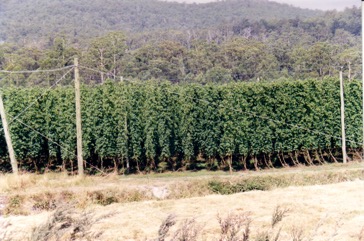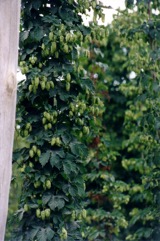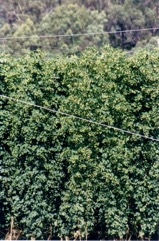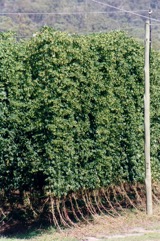Common hop, Hop

It is a temperate plant. They prefer moist but well-drained soil. Plants are frost hardy. It cannot tolerate salty seaside conditions. They do best with a pH of 5.5-7. In the Himalayas it grows between 3,000-3,700 m above sea level. It suits hardiness zones 5-10. Hobart Botanical Gardens.
Also known as:
Bin, Bine, Byit-pan, Chmiel, Hmelj, Hopfen, Houblon, Humal, Khmel, Khmeyel', Komlo, Luppolo, Lupporo, Lupulo, Navadni hmelj, Shashquta, Vadkomlo
Edible Portion
- Leaves, Flowers, Herb, Spice, Vegetable, Rhizome, Root
Where does Common hop grow?
Found in: Africa, Argentina, Armenia, Asia, Australia, Austria, Balkans, Belarus, Belgium, Bosnia, Britain, Canada, Caucasus, China, Cyprus, Czech Republic, East Africa, Estonia, Ethiopia, Europe, Finland, France, Georgia, Germany, Himalayas, Hungary, India, Ireland, Italy, Korea, Lithuania, Luxembourg, Macedonia, Mediterranean, Morocco, Myanmar, North America, Pakistan, Russia, Scandinavia, Serbia, Slovenia, South America, Spain, Sweden, Tasmania, Turkey, Ukraine, United States
Notes: There are 2 Humulus species.
Status: It is a commercially cultivated vegetable.
Growing Common hop, Hop
Cultivation: Plants are grown from semi-ripe cuttings. Plants are placed 2.5 m apart and need a structure to climb. Sometimes plants are grown from seeds if the cultivars set seed.
Edible Uses: The overlapping bracts which cover the female flower are used in brewing. They flavour beer and act as a preservative. Hops can also be used to make bread rise. They are dried and the oil has a smell. The flowers are used in bread. The young shoots are cooked and eaten. They are stewed, used in soups and also used in omelettes. Caution: Hops can cause mild depression.
Production: It is fast growing. Plants start producing cones when about 3 years old. The cones are harvested just before fully ripe and carefully dried at less than 65°C.
Nutrition Info
per 100g edible portion| Edible Part | Energy (kcal) | Protein (g) | Iron (mg) | Vitamin A (ug) | Vitamin c (mg) | Zinc (mg) | % Water |
|---|---|---|---|---|---|---|---|
| - | - | - | - | - | - |
Common hop, Hop Photos




References
Ambasta, S.P. (Ed.), 2000, The Useful Plants of India. CSIR India. p 275
Beckstrom-Sternberg, Stephen M., and James A. Duke. "The Foodplant Database." http://probe.nalusda.gov:8300/cgi-bin/browse/foodplantdb.(ACEDB version 4.0 - data version July 1994)
Bianchini, F., Corbetta, F., and Pistoia, M., 1975, Fruits of the Earth. Cassell. p 214
Biscotti, N. et al, 2018, The traditional food use of wild vegetables in Apulia (Italy) in the light of Italian ethnobotanical literature. Italian Botanist 5:1-24
Blamey, M and Grey-Wilson, C., 2005, Wild flowers of the Mediterranean. A & C Black London. p 36
Bodkin, F., 1991, Encyclopedia Botanica. Cornstalk publishing, p 567
Bremness, L., 1994, Herbs. Collins Eyewitness Handbooks. Harper Collins. p 279
Brickell, C. (Ed.), 1999, The Royal Horticultural Society A-Z Encyclopedia of Garden Plants. Convent Garden Books. p 536
Brouk, B., 1975, Plants Consumed by Man. Academic Press, London. p 305
Brown, D., 2002, The Royal Horticultural Society encyclopedia of Herbs and their uses. DK Books. p 237
Bussman, R. W., et al, 2016, A comparative ethnobotany of Khevsureti, Samtskhe-Javakheti, Tusheti, Svaneti, and Racha-Lechkhumi, Republic of Georgia (Sakartvelo), Caucasus. Journal of Ethnobiology and Ethnomedicine (2016) 12:4
Bussman, R. W. et al, 2017, Ethnobotany of Samtskhe-Javakheti, Sakartvelo (Republic of Georgia), Caucasus. Indian Journal of Traditional Knowledge Vol. 16(1) pp 7-24
Cerne, M., 1992, Wild Plants from Slovenia used as Vegetables. Acta Horticulturae 318.
Christanell, A., et al, 2010, The Cultural Significance of Wild Gathered Plant Species in Kartitsch (Eastern Tyrol, Austria) and the Influence of Socioeconomic Changes on Local Gathering Practices. Chapter 3 in Ethnobotany in the New Europe. Berghahn Books.
Crawford, M., 2012, How to grow Perennial Vegetables. Green Books. p 119
Cundall, P., (ed.), 2004, Gardening Australia: flora: the gardener's bible. ABC Books. p 715
Denes, A., et al, 2012, Wild plants used for food by Hungarian ethnic groups living in the Carpathian Basin. Acta Societatis Botanicorum Poloniae 81 (4): 381-396
Ertug, F, Yenen Bitkiler. Resimli Türkiye Florası -I- Flora of Turkey - Ethnobotany supplement
Facciola, S., 1998, Cornucopia 2: a Source Book of Edible Plants. Kampong Publications, p 70
Flora of Australia, Volume 3, Hamamelidales to Casuarinales, Australian Government Publishing Service, Canberra (1989) p 14
Flora of Pakistan. www.eFlora.org
Hedrick, U.P., 1919, (Ed.), Sturtevant's edible plants of the world. p 350
Heywood, V.H., Brummitt, R.K., Culham, A., and Seberg, O. 2007, Flowering Plant Families of the World. Royal Botanical Gardens, Kew. p 85
Hibbert, M., 2002, The Aussie Plant Finder 2002, Florilegium. p 143
Hu, Shiu-ying, 2005, Food Plants of China. The Chinese University Press. p 362
Irving, M., 2009, The Forager Handbook, A Guide to the Edible Plants of Britain. Ebury Press p 190
Joyce, D., 1998, The Garden Plant Selector. Ryland, Peters and Small. p 182
Kalle, R. & Soukand, R., 2012, Historical ethnobotanical review of wild edible plants of Estonia (1770s-1960s) Acta Societatis Botanicorum Poloniae 81(4):271-281
Kays, S. J., and Dias, J. C. S., 1995, Common Names of Commercially Cultivated Vegetables of the World in 15 languages. Economic Botany, Vol. 49, No. 2, pp. 115-152
Kiple, K.F. & Ornelas, K.C., (eds), 2000, The Cambridge World History of Food. CUP p 433, 1786
Lazarides, M. & Hince, B., 1993, Handbook of Economic Plants of Australia, CSIRO. p 134
Lim, T. K., 2015, Edible Medicinal and Non Medicinal Plants. Volume 9, Modified Stems, Roots, Bulbs. Springer p 47
Luczaj, L. et al, 2012, Wild food plant use in 21st century Europe: the disappearance of old traditions and the search for new cuisines involving wild edibles. Acta Soc Bot Pol 81(4):359–370
Łuczaj, L., et al, 2013, Wild edible plants of Belarus: from Rostafiński’s questionnaire of 1883 to the present. Journal of Ethnobiology and Ethnomedicine 2013, 9:21
Luczaj, L. et al, 2017, Comfrey and Buttercup Eaters: Wild Vegetables of the Imereti Region in Western Georgia, Caucasus. Economic Botany, 71(2), 2017, pp. 188–193
Lyle, S., 2006, Discovering fruit and nuts. Land Links. p 244
Mabey, R., 1973, Food for Free. A Guide to the edible wild plants of Britain, Collins. p 93, 153
MacKinnon, A., et al, 2009, Edible & Medicinal Plants of Canada. Lone Pine. p 160
Michael, P., 2007, Edible Wild Plants and Herbs. Grub Street. London. p 127
Moerman, D. F., 2010, Native American Ethnobotany. Timber Press. p 269
Molla, A., Ethiopian Plant Names. http://www.ethiopic.com/aplants.htm (As Humulus sp.)
Neve, R.A., 1979, Hops, in Simmonds, N.W., (ed), Crop Plant Evolution. Longmans. London. p 209
Paczkowska, G . & Chapman, A.R., 2000, The Western Australian Flora. A Descriptive Calatogue. Western Australian Herbarium. p 565
Pieroni, A., 1999, Gathered wild food plants in the Upper Valley of the Serchio River (Garfagnana), Central Italy. Economic Botany 53(3) pp 327-341
Pieroni, A. & Soukand, R., 2018, Forest as Stronghold of Local Ecological Practice: Currently Used Wild Food Plants in Polesia, Northern Ukraine. Economic Botany, XX(X) pp. 1-21
Pieroni, A., et al, 2020, Wild food plants traditionally gathered in central Armenia: archaic ingredients or future sustainable foods? Environment, Development and Sustainability. Springer p 8
Plants for a Future database, The Field, Penpol, Lostwithiel, Cornwall, PL22 0NG, UK. http://www.scs.leeds.ac.uk/pfaf/
Rawat, G.S., & Pangtey, Y.P.S., 1987, A Contribution to the Ethnobotany of Alpine Regions of Kumaon. J. Econ. Tax. Bot. Vol. 11 No. 1 pp 139-147
Redzic, S. J., 2006, Wild Edible Plants and their Traditional Use in the Human Nutrition in Bosnia-Herzegovina. Ecology of Food and Nutrition, 45:189-232
Redzic, S., 2010, Use of Wild and Semi-Wild Edible Plants in Nutrition and Survival of People in 1430 Days of Siege of Sarajevo during the War in Bosnia and Herzegovina (1992–1995). Coll. Antropol 34 (2010) 2:551-570
Sanchez-Mata, M. C., et al, 2010, Wild vegetables of the Mediterranean area as valuable sources of bioactive compounds. Genet. Resourc. Crop Evol. 59:431-443
Sansanelli, S., et al, 2014, Wild food plants traditionall consumed in the area of Bologna (Emilia Romagna region, Italy). Journal of Ethnobiology and Ethnomedicine 10:69
Seidemann J., 2005, World Spice Plants. Economic Usage, Botany, Taxonomy. Springer. p 179
Sharma, L. et al, 2018, Diversity, distribution pattern, endemism and indigenous uses of wild edible plants in Cold Desert Biosphere Reserve of Indian Trans Himalaya. Indian Journal of Traditional Knowledge. Vol 17(1) January 2018 pp 122-131
Simkova, K. et al, 2014, Ethnobotanical review of wild edible plants used in the Czech Republic. Journal of Applied Botany and Food Quality 88, 49-67
Soukand, R., et al, 2017, Multi-functionality of the few: current and past uses of wild plants for food and healing in Liubań region, Belarus. Journal of Ethnobiology and Ethnomedicine (2017) 13:10
Sp. pl. 2:1028. 1753
Tardio, J., et al, Ethnobotanical review of wild edible plants in Spain. Botanical J. Linnean Soc. 152 (2006), 27-71
Turner, N. J. et al, 2011, Edible and Tended Wild Plants, Traditional Ecological Knowledge and Agroecology. Critical Reviews in Plant Sciences, 30:198-225
van Wyk, B., 2005, Food Plants of the World. An illustrated guide. Timber press. p 211
World Checklist of Useful Plant Species 2020. Royal Botanic Gardens, Kew
www.eFloras.org Flora of China